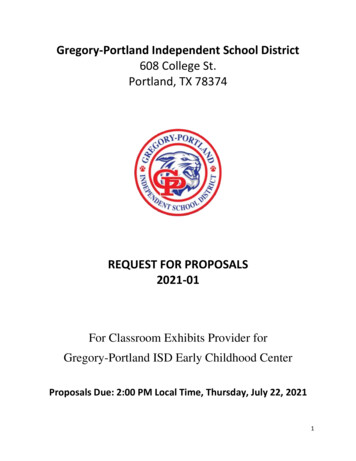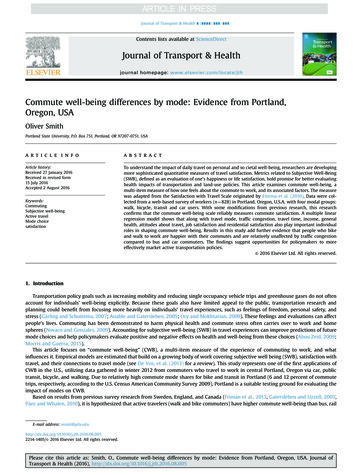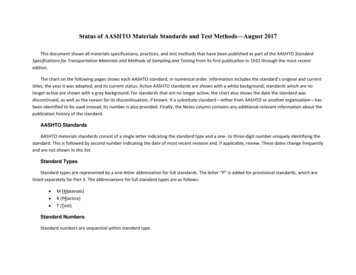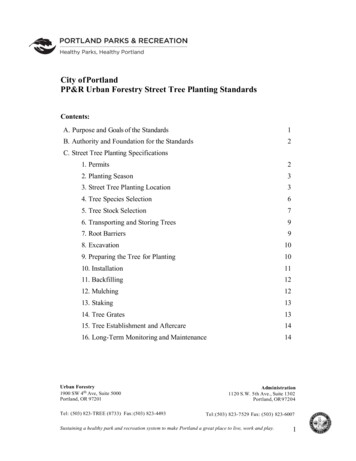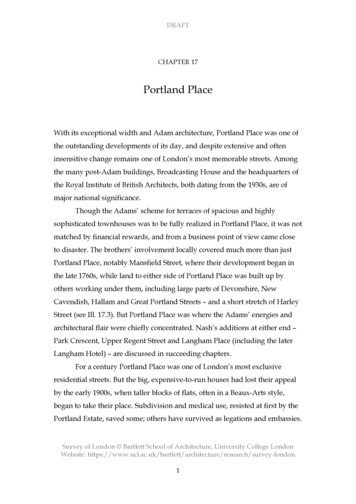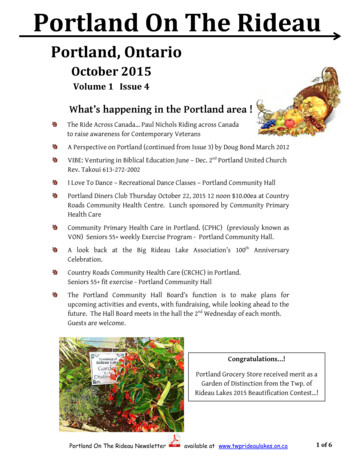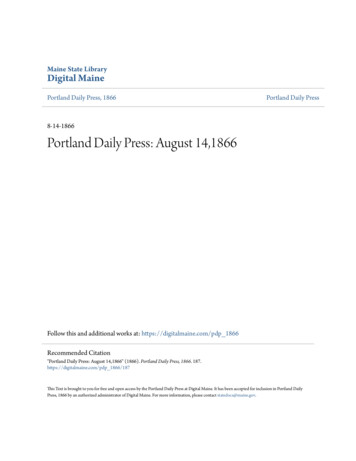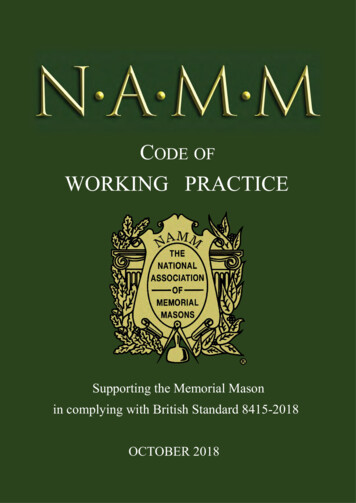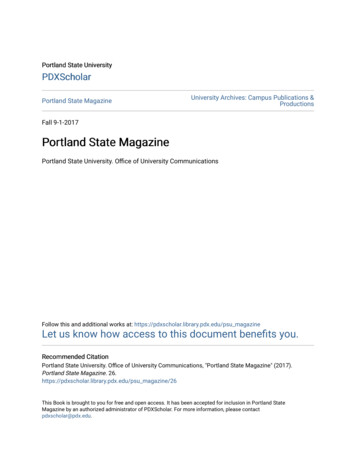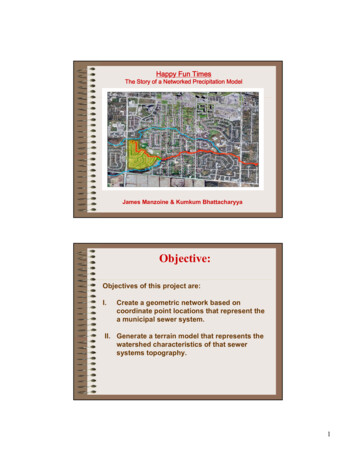
Transcription
Happy Fun TimesThe Story of a Networked Precipitation ModelJames Manzoine & Kumkum BhattacharyyaObjective:Objectives of this project are:I.Create a geometric network based oncoordinate point locations that represent thea municipal sewer system.II. Generate a terrain model that represents thewatershed characteristics of that sewersystems topography.1
Developing the Geodatabase andArcHydro ModelHydrologic ModelingArc HydroGeodatabaseHydrologic Information System (Maidment, 2002)ArcHydro data model for water resources2
Working Steps Field Work: Gathering GPS Coordinates Network: Establishing Topology and Relationsin Building a Geometric Network Terrain Assessment: Building a WatershedBased on a DEM Modeling: Relating the Network to theWatershed Results: A Time Series HydrographRepresenting Discharge Rates per OutfallA Friendly Neighborhood3
The Study AreaSurveying the FieldAn isolated area was selected on DEM Looked for areawith few externalsources and descentrelief in elevation GPS coordinatesrecorded for allmanholes, inlets, andoutfalls via Goe XT GPS coordinatesimported andconverted to .SSF filevia GPS Pathfinder3.2 Coordinatelocations imported astable into ArcGIS andconverted into apoint shapefile4
Point AttributesBuilding Drainage Network A geodatabase was createdand a feature dataset wasestablished to store networkfeatures. The point shapefile was thenimported into the featuredataset and polyline shapefilewere then created andimported into ArcMap Polylines were then digitizedin the direction of flow torepresent pipe connections ofthe sewer system A geometric network wasthen established using thepoint locations and digitizedpolylines. This created a system ofjunction points which will laterbe used to populate the mapsvisual features.5
Terrain Processing A DEM of the area was clipped to encompass on the area ofinterest before the sinks were filled using the “Fill” tool. ArcHydro was then opened, and the Terrain Preprocessing toolswere utilized.These tools were used to establish the following layers: Flow directionsFlow accumulationsStream definitionsStream segmentationsCatchments polygonsFlow linesAdjoined catchmentsDrainage points, slopesFlow pathsTerrain Elevation6
Flow directionsFlow Accumulations & Slope7
Flow linesThese layers are then connected via the TerrainMorphology tool set to generate relationship based tablesand schematically displayed layers8
Watershed Networking Upon generating thedesired layers andestablishing theappropriateconnections ahydro network wasestablished torepresent thedynamics of watershedflow This network isbased off of the flowlines, drainage points,and catchments thatwere generated viaTerrain Processing.Watershed9
Attribute Building Now that the hybrid network models are built, severalattribute fields must be calculated for modelingrelationships These attributes include HydroIDs, To/From Nodes,NextDownIDs, DrainIDs, GridIDs, FlowDir,LengthDown, and Type fields. The vast majority of these fields were established viaAttribute Tools in ArcHydro, but some like DrainIDand GridID were established by spatial and attributejoins. Upon calculating the attributes of the models, thejunctions were then assigned an Ancillary Role(Source, Sink, or None).Relationship Building Catchments Have Drainage Points (HydroID - GridID) DrainagePoints Have Watershed Junctions (JunctionID - HydroID) Note: Specified Connections were Joined TogetherManually Watershed Junctions Have Network Junctions (HydroID - DrainID) Note: This relationship is the hybrid point of the twomodels Network Junctions Have Network Drainage Points (HydroID - JunctionID) Network Drainage Points Have Network Outfall Sinks (HydroID - DrainID) Network Junctions Have Network Outfall Sinks (HydroID - JunctionID) Network Sinks Have Values Table (HydroID - SinkID)Note: This relationship stores accumulation data10
Drainage Point Schematic Relationships Map(after manual manipulation of DrainIDs)Establishing Schematic References Based on RelationshipsThis Schematic maps represent the relationships held between theNetworks Outfall (Sink) Schematic Relationships Map11
Attribute Consolidation and Accumulation The attribute tables of both models wereseparately consolidated and accumulated. Consolidating the related attribute fieldssummarizes the properties of features in onerelated class to another Accumulating the related attribute fieldsassigns drainage area properties downstreamConsolidate / Accumulate Attributes12
Modeling Intentions Combine Network to Watershed Integrate Precipitation Data to Model Make the Network “active” in DrainingCatchments Automate Drainage Over Time Produce Time Series Data for DischargeRatesCompute Local ParametersUpon generating all of these layers and relationships the model wasset “Compute Local Parameters”This tool took theprecipitation dataand implied it tomodel to generatevolumetric resultsin the assigneddata table.Results:The map failed tomodel the results .Questions?13
Reasons Why? After many attempts and discussions withDr. Duh, we determined that ESRI cannotsupport two Hybrid models. This is because a Sink in one model cannotbe determined as a Source in another. In order to properly represent the modelone must make a single master model thatwith separate sink watersheds.Watershed14
Establishing Schematic References Based on RelationshipsThis Schematic maps represent the relationships held between theNetworks Outfall (Sink) Schematic Relationships MapDrainage Point Schematic Relationships Map(after manual manipulation of DrainIDs)15
Future Plans? Future attempts might be made oncorrecting this model, but no promises willbe made at this point. Mike Urban: A software program thatmight be able to correctly model asewershed.References Carlos Patino-Gomez, Daene C. McKinney and David R. Maidment. 2007. Water QualityData Model in GIS for the Rio Bravo/Grande aceAndTime/ESRI 2007 Patino.htm ESRI Virtual Campus Course, Creating and Integrating Data for Natural ResourceApplications, completed ESRI certified Training, 12 course hours, December, 2006 ESRI Virtual Campus Course, Creating, Editing, and Managing Geodatabases for ArcGISDesktop, ESRI certified Training in progress Maidment, David R (Ed). 2002. Arc Hydro. GIS for Water Resources, ESRI press,California, 203 pp. m?TopicName Geometric network connectivity rules, accessed on November 25th, 200816
Questions?Thanks!17
ESRI Virtual Campus Course, Creating and Integrating Data for Natural Resource Applications, completed ESRI certified Training, 12 course ho urs, December, 2006 ESRI Virtual Campus Course, Creating, Editing, and Managing Geodatabases for ArcGIS Desktop, ESRI certified Training in progress Maidment, David R (Ed). 2002. Arc Hydro.

